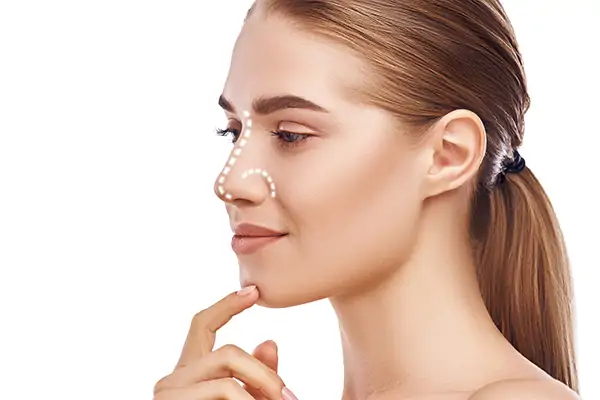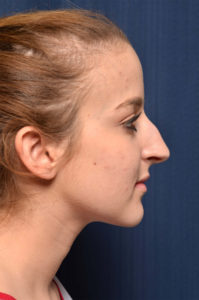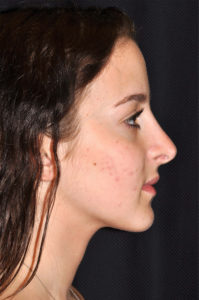Please call 754-277-4120 to schedule an appointment at our convenient location in Fort Lauderdale. Dr. Michael Frederick also serves the surrounding Broward County towns of Weston, Hollywoood and Cooper City. We also welcome patients from the Miami area, including Aventura and Coral Gables. Dr. Frederick also has strong ties to our Palm Beach neighbors from Boca Raton, West Palm Beach, Palm Beach Gardens and Jupiter.
Every nose is different and so every rhinoplasty has to be different as well. Dr. Frederick will discuss with you your goals and anatomy so that you can form a detailed pre-operative rhinoplasty plan together. Using his artistic talent and surgical precision he will then shape the nose that you desire. Browse through our collection of rhinoplasty before and after photos, then read below for more information.

Rhinoplasty
Closed
About
There are two main rhinoplasty techniques: open and closed. In the past a closed rhinoplasty was very common but it allows poor visibility of the nasal construct and minimal control over the shaping of the tip. Modern rhinoplasty patients are very discerning and particular about what they want their nose to look like. An open approach provides the direct visualization and access to be able to adjust the dorsum, perform precise surgical maneuvers and create a perfectly refined tip. An open rhinoplasty uses a small incision along the columella that virtually disappears. The skin of the nasal tip is then flipped up to expose the cartilage framework underneath which is adjusted via numerous defined rhinoplasty techniques.
Procedures
There are numerous rhinoplasty techniques that have been described that are in the toolbox of any good rhinoplasty surgeon. However, there are some basic techniques or concepts that are almost uniformly performed that are described below. Dr. Frederick will pick from these techniques and others to artfully shape and mold the nose much like a master sculptor.
- Dorsal Hump reduction: Most rhinoplasty patients want a smaller nose and this often means taking down the bump. This is done through shaving down under direct visualization the cartilage and the nasal bones. However, once this is performed and the dorsum is straight, the nose will widen and flatten. (Think about how cutting off the top of a pyramid would create a flat top) This is why in almost every rhinoplasty with a dorsal reduction the bones need to be broken inward. This narrows the nose and gives it back its shape.
- Lower Lateral Cephalic Trim: A large or bulbous tip is often cause by an extra large piece of cartilage that needs to be trimmed. During the rhinoplasty the trimming is done in such a manner to leave behind only what is required to maintain structural support so that the tip can be as refined as possible. This will also help elevate the tip so it doesn’t droop down and you get an appropriate angle between your nose and your lips.
- Tip sutures: There are many defined tip suture techniques in rhinoplasty including transdomal sutures, interdomal sutures and tip defining point sutures to name a few. Dr. Frederick will be selecting the most optimal of these specific to what is needed for each individual nose.
- Grafts: Rhinoplasty grafts are commonly used to help maintain structure and integrity of the new nose. These can include columellar strut grafts to support the tip, tip grafts for increased projection and shaping or alar rim grafts to shape the nostrils.
- Nostril Narrowing: In rhinoplasty jargon this is called a “Weir resection.” This rhinoplasty technique removes some of the nostril skin to narrow the nose while hiding the incision long the base in the crease. Some patients know before the rhinoplasty that they will need this technique but often the surgeon has to use his artistic eye to evaluate on the table whether it is needed after the nose is narrowed with the in fracture of the bones.
Candidates
A good candidate for rhinoplasty is anyone who is dissatisfied with the appearance of their nose and has realistic expectations of their result. While there are nearly infinite rhinoplasty techniques to adjust the nose is every dimension, there will always be some potential limitations to what can be achieved based upon each patients anatomy.
The most common example of this is when patients have very thick skin at the tip. This can limit how small the tip can be despite maximally reducing the cartilage structure underneath.
Secondary Rhinoplasty
Secondary rhinoplasty aims to revise previous rhinoplasties with an unsatisfactory outcome. Due to the scarring from the previous surgery these must be done through an open approach and the healing and outcome can be less predictable. Cartilage grafts are often required and can be harvested from the septum (which is inside the nose), the back of the ear or the ribs.
Recovery
Rhinoplasty patients will wear a nasal splint that is removed in the office at one week. Bruising and swelling are common. At three weeks the swelling should be reduced significantly such that no one will be able to tell that you have had an operation. However, residual swelling in the nasal tip can be persistent. This will slowly decrease with time and may not fully resolve for 6-12 months after the rhinoplasty.
Complimentary Procedures
A chin augmentation is commonly performed along with a rhinoplasty to create facial harmony and balance. A lip lift procedure can also be performed with a rhinoplasty while hiding the scar along the base of the nose.
*RESULTS MAY VARY


